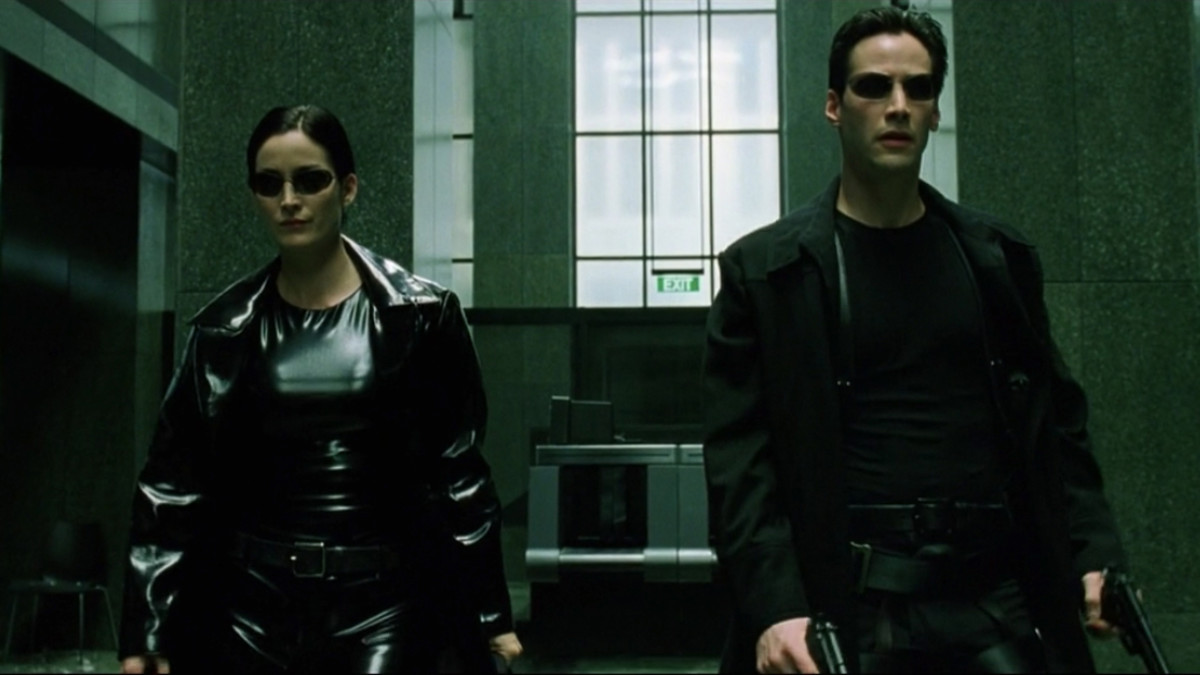The Matrix (1999)

Neo (Keanu Reeves) and Trinity (Carrie-Anne Moss). Photo: Screengrab/The Matrix
Only a handful of films have left as lasting an impact on fashion as The Matrix, with Kym Barrett’s costume design transcending the film’s late-90’s origins and remaining just as relevant today.
The Wachowskis’ sisters’ sci-fi cyberpunk film The Matrix hit cinemas in 1999 and is a prime example of the undeniable influence of the science fiction genre on fashion. The film features an array of outfits that play with textures and silhouettes while complementing the characters’ stories.
Much of this is credited to the film’s costume designer, Kym Barrett. Her vision was to let other storytelling elements take the centre of the stage, but it is exactly this approach that makes the fashion choices stand out. “All I thought was: How can I make these worlds be real and be distinctive?”
Fashion was the last thing on Barrett’s mind when it came to her approach to the film’s costuming, and it is through this simplistic and straightforward costume design that the film has achieved a distinct aesthetic that appears authentic to the characters. The character’s outfits are instantly recognizable – sleek leather jackets, tiny sunglasses, latex and minimal yet bold silhouettes – but they never feel out of place.
Although The Matrix is set around the year 2199 with present-day being portrayed as a simulation, its costuming avoids the overly futuristic look seen in many other sci-fi films. Instead, it leans into functionality, experimenting with materials and silhouettes to present a more grounded vision of what fashion might look like in 200 years. The aesthetics of the film’s costumes suggest that, rather than outlandish outfits, people would adopt practical, utilitarian styles that integrate futuristic elements into everyday wardrobes. This is an example of costuming that effortlessly blends into the story, and it all seems very intentional.
Beyond aesthetics, the costume design serves a deeper purpose. Barret made the best out of it to reflect the film’s core themes of identity, transformation and the tension between control and freedom.
Dressing for transformation
A closer look at Neo’s wardrobe evolution reveals the tight link between costume design and character development. In the beginning of the film, there is a clear distinction between Neo’s attire and that of the other characters – while the agents wear their sharp suits with sunglasses and Trinity moves with precision in her sleek bodysuit, Neo is dressed in casual, almost ill-fitting clothes. It reflects his uncertainty and feeling trapped within the confines of his mundane world.
As the film progresses and Neo comes to terms with his role as ‘The One’, his wardrobe shifts as he adopts the same polished all-black look of Trinity and Morpheus. Neo donning the long, flowing trench coat and dark sunglasses marks the completion of his transformation, a visual mark of his newfound confidence and control over his reality.
The contrasts between characters is also an important nod to their roles in the story. Trinity’s skintight wardrobe and short hair exude precision, functionality and discipline. All while Morpheus carries an air of authority on the shoulders of his structured coats.
The lasting fashion legacy
The Matrix’s relevance in fashion dates back to its premiere in 1999, reflecting and shaping late ‘90s and early 2000s trends. Shortly after the film’s release, John Galliano sends PVC materials and micro-glasses down Dior’s AW 1999 haute couture runway and Janet Jackson dons an all-leather look at the 2000 MTV Awards. In recent times, the film still remains a snapshot of 90s fashion with a forward-thinking vision and acts as a good reference point for both past and present styles.
From 2017 onwards, we are faced with a ‘90s revival and The Matrix style being brought back into the trend cycle, with micro-glasses and leather wiggling their way back into everyday wardrobes. In a 2018 interview with Glamour, Kim Kardashian revealed that Kanye had once emailed her that she “can’t wear big sunglasses anymore”, declaring tiny sunglasses as the new trend. We later see Rihanna in micro-glasses at the 2018 Cannes Film Festival.
Fashion has only fallen deeper into the matrix since then, the style being adopted by countless celebrities and multiple subcultures. Thoughts of the Berlin rave community and the opium street style aesthetic arise when trying to associate the film with real-life adaptations of its style.
The film’s aesthetic remains a staple in pop culture, continuously resurfacing on runways and in street style. More than two decades later, Kym Barrett’s costume choices still feel relevant and prove that well-designed and purpose-driven costuming never goes out of style. Beyond looking cool, the film’s fashion is about functionality, identity and transformation, reminding us that true fashion is built not only on aesthetics but on the power of storytelling.
By Seren Rifat, a student on the BA Journalism course at London College of Communication

